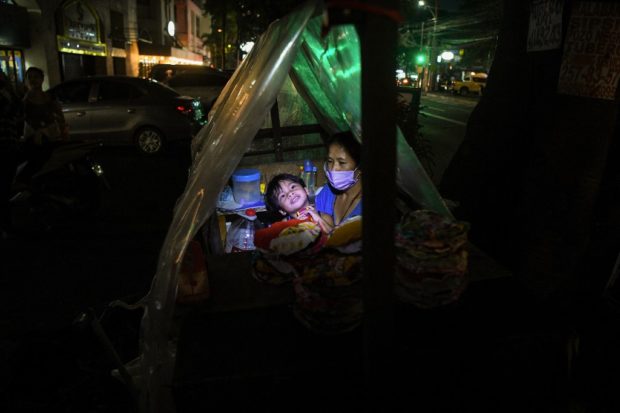
This photo taken on August 24, 2022 shows Maricel Abawag and her son resting inside their pushcart ‘home’ next to a residential condominium building in Quezon City, suburban Manila. Pushcarts, known as karitons, are a common sight in the city of more than 13 million people. Often made from scraps of wood, the human-powered carts are used as shelter, storage and a source of income, such as collecting trash to sell to recyclers. (Photo by Ted ALJIBE / AFP)
MANILA, Philippines — Like thousands of homeless people in the Philippine capital Manila, Maricel Abawag and her son slept on flattened cardboard boxes on footpaths. Then they got a pushcart.
Pushcarts, known as karitons, are a common sight in the city of more than 13 million people.
Often made from wood scraps, the human-powered carts are used as a shelter, storage and a source of income, such as collecting trash to sell to recyclers.
Abawag, 44, received her pushcart in November 2020 from a Catholic brother.
About a year earlier, Abawag had “lost everything” when her partner was jailed for beating her. He died of a heart attack in custody.
She began sleeping on the streets while still breastfeeding her baby.
“If I were to look for a house we would need to pay rent,” Abawag told AFP.
“Then we would need to pay for electricity, water, rice and milk — I don’t have enough money.”
Nearly 50 percent of Filipino families consider themselves poor, according to the latest survey by research organization Social Weather Stations.
Many live in overcrowded slums or on the streets.
This photo on November 29, 2022 shows a group of homeless people resting beside their pushcart outside an abandoned building in Quezon City, suburban Manila. Pushcarts, known as karitons, are a common sight in the city of more than 13 million people. Often made from wood scraps, the human-powered carts are used as a shelter, storage and a source of income, such as collecting trash to sell to recyclers. (Photo by Ted ALJIBE / AFP)
‘I’m not afraid’
Ed Billones, who donated the pushcart to Abawag, said people without homes were often viewed as “lazy and addicts.”
In reality, many have come from the provinces in search of work that did not materialize or were forced from their homes by domestic abuse or the loss of the family breadwinner.
Scavenger Boyet Torres, 59, said he fled a violent father decades ago.
He has lost count of the number of pushcarts confiscated by local officials during street-clearing operations.
This photo taken on November 29, 2022 shows a group of homeless people preparing to sleep beside their pushcart outside an abandoned building in Quezon City, suburban Manila. (Photo by Ted ALJIBE / AFP)
“If I don’t have one, I’m unable to earn,” said Torres, who collects plastic bottles and cardboard.
“I’ll only earn 30 pesos (54 cents) a day (using sacks), and that’s just enough for food. If I have a kariton, I can earn up to 150 pesos.”
This photo taken on August 24, 2022 shows Maricel Abawag and her son getting out from their pushcart ‘home’ next to a residential condominium building in Quezon City, suburban Manila. (Photo by Ted ALJIBE / AFP)
Every night, Abawag and her now four-year-old son sleep inside their pushcart parked under a tree on the footpath of a busy street.
The cart is 1.6 meters (5.2 feet) long and 31 centimeters (about one foot) wide and contains all their worldly goods like a torch, radio, soap, pillows, blankets and toys.
When it rains, Abawag pulls a transparent plastic sheet over the top to keep them dry.
Meters away, people eat at restaurants that Abawag will likely never be able to afford.
After losing a precious bag of clothes to a thief, Abawag locks the pushcart and secures it to the tree before she sets out on foot every day to sell rags.
“If I sell enough rags, I buy food. If I don’t have any sales then I wait for people to give us food,” she said.
Abawag said she was embarrased when she began living on the streets. But her religious faith helped her adjust.
“I’m not afraid to live on the street because I pray to God to not abandon us,” she said.